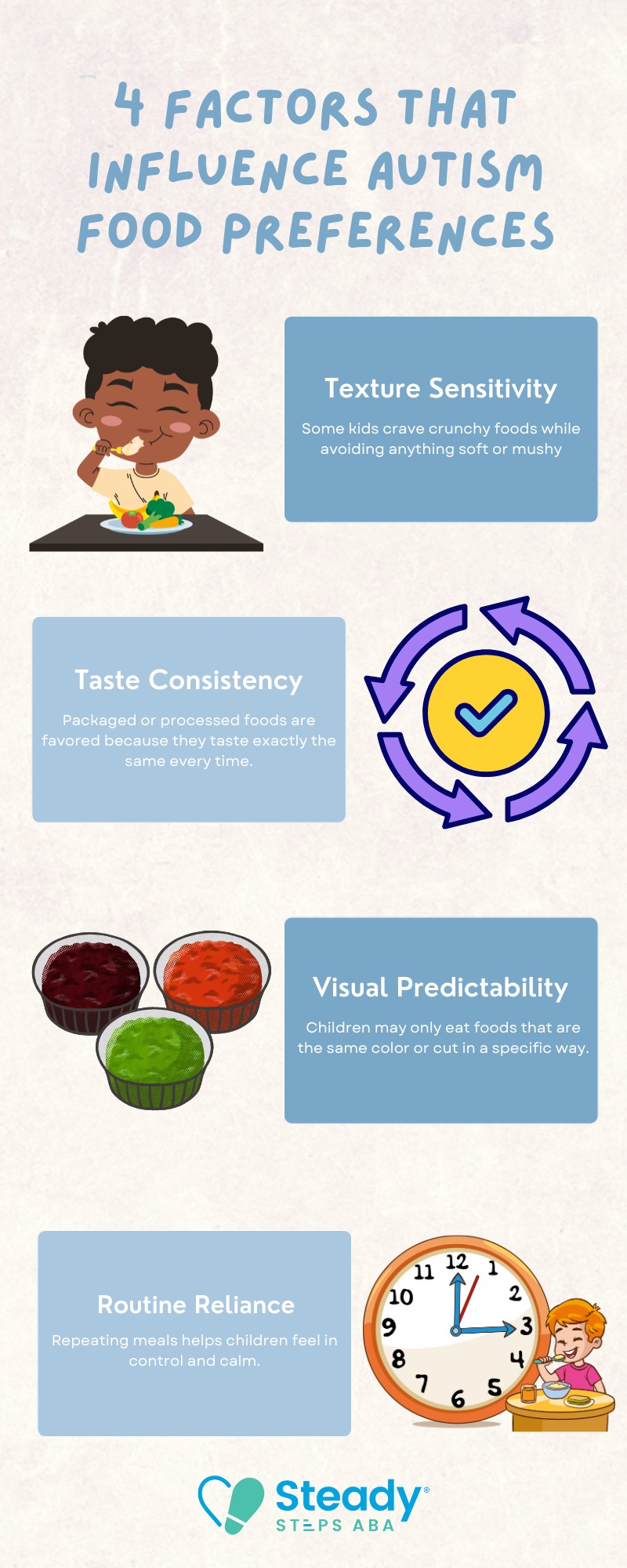Key Points:
- Autism comfort foods are meals that feel safe, predictable, and soothing for individuals with autism, often due to their texture, flavor, or routine familiarity.
- These foods can play an important role in managing sensory sensitivities and feeding challenges common in autism spectrum disorder (ASD).
- With patience and strategy, families can build variety into comfort-based meals to support nutrition without overwhelming sensory systems.
Approximately 90% of autistic individuals experience sensory processing disorders, which often means that they prefer things that are familiar and safe. Autism comfort food refers to familiar, predictable meals that provide sensory relief and emotional safety to individuals with autism. These foods are often chosen based on texture, taste, smell, or appearance and may become essential in a child’s daily routine.
For many parents, finding the right autism comfort food can reduce mealtime battles and provide a reliable source of nutrition. Unlike typical food preferences, comfort foods for autistic individuals often go beyond taste.
They help regulate a child’s sensory experience and bring structure to a sometimes overwhelming world. In this article, we’ll go over some common autism comfort foods and offer some tips to help your child overcome feeding challenges.
Why Do Children With Autism Prefer Specific Comfort Foods?
Children with autism often face challenges with sensory processing, meaning their brains react more intensely—or differently—to sensory input like textures, smells, or colors. Comfort foods offer consistency, which reduces sensory surprises and anxiety.
Autism-related food preferences are frequently shaped by:

These preferences are rarely about being “picky” and more about managing sensory input and maintaining emotional regulation.
8 Most Common Autism Comfort Foods
The comfort foods commonly chosen by children with autism often share predictable characteristics—smooth textures, mild flavors, or a specific temperature. While every child is unique, certain foods come up time and again in households across the autism community.
Frequently preferred autism comfort foods include:
- Plain pasta or macaroni and cheese
- Chicken nuggets or tenders
- French fries or hash browns
- Peanut butter sandwiches
- Yogurt or applesauce
- Dry cereal (e.g., Cheerios, Rice Krispies)
- White bread or crackers
- Bananas or sliced apples (peeled or unpeeled, depending on preference)
These foods are often served the same way every time—same plate, same portion, same presentation. The familiarity helps children feel secure and more in control of their eating experience.
Balancing Taste and Health: The New Take on Comfort Foods
While comfort foods offer predictability and safety, they may not always provide complete nutrition. Parents often worry about vitamin deficiencies or limited food variety. The good news is that nutritional gaps can be gently addressed without disrupting your child’s comfort zone.
Rather than eliminating favorite meals, consider layering nutrition into them or using similar textures to introduce healthier options.
Strategies to boost nutrition through comfort foods include:
1. Add Pureed Vegetables to Sauces
Blending veggies like carrots or squash into familiar sauces, such as mac and cheese, can boost nutrition without changing flavor too much. It’s a simple way to sneak in extra nutrients while keeping meals comforting and recognizable.
2. Offer Fortified Versions of Favorite Snacks
Choose snacks that look and taste the same but have more nutritional value, like whole grain crackers or vitamin-enriched cereals. This helps improve diet quality without asking your child to give up their go-to foods.
3. Use Dips or Toppings
Pairing familiar dips like hummus, guacamole, or Greek yogurt with fruit or preferred chips can make new or less-favored foods more approachable. Dips add fun and flavor while offering extra nutrients.
4. Pair Safe Foods with New Ones
Serving a new food next to a “safe” food on the same plate, without any pressure to eat it, builds comfort over time. Just seeing and smelling the new item can be a meaningful step forward.
5. Offer Smoothie Versions of Foods
If your child prefers liquids, try blending fruits, veggies, and proteins into smoothies. This is an easy way to pack in nutrients with a texture that may be more acceptable or soothing.
The goal is to honor your child’s sensory needs while supporting their physical development—one familiar meal at a time.
Why Sensory Processing Affects Eating Behavior in Children
Food aversions in autism often originate from sensory overstimulation. This includes hypersensitivity to sounds (like chewing), smells, visual input, or oral textures. Comfort foods tend to be safe because they reduce these sensory “surprises.”
Understanding your child’s sensory triggers can guide which foods are best tolerated and which to avoid.
Common sensory-based food challenges include:
1. Texture Aversion
Creamy, mushy, or mixed-texture foods can feel unpredictable or unpleasant to sensitive eaters. These textures may trigger discomfort, gagging, or outright refusal based on how they feel in the mouth.
2. Temperature Sensitivity
Foods that are too hot or too cold can cause discomfort or even pain for children with heightened sensory awareness. Serving food at room temperature can help make mealtimes more tolerable.
3. Strong Odors
Pungent smells like fish, eggs, or broccoli may be overwhelming even before the food reaches the table. The aroma alone can cause distress or refusal, especially in a closed space like a kitchen.
4. Color or Shape Aversion
Some children feel more comfortable eating foods that look a certain way—often white, beige, or cut into uniform shapes. Any variation in color or presentation might lead to anxiety or rejection.
By identifying which sensory inputs cause stress, you can modify meals accordingly—like offering warm rather than hot food, peeling fruits, or using consistent plating.
How Can Parents Expand Their Child’s Diet Without Losing Comfort
Diet expansion doesn’t have to mean sacrificing comfort. The goal is not to replace favorite meals, but to build bridges from those meals to new, tolerable ones. This process takes time and may require creative problem-solving.
One effective technique is food chaining—gradually modifying a safe food to become more nutritious or varied while keeping the sensory experience similar. Always introduce changes slowly and in small amounts. Repetition, patience, and neutral reactions are key.
5 Warning Signs of Unhealthy Eating Patterns
It’s important to distinguish between typical comfort-based eating and extremely restrictive eating that may require professional help. If a child’s eating habits are impacting their health, growth, or emotional well-being, it may be time to consult with a therapist or feeding specialist.
Red flags to watch out for include:
1. Fewer Than 10 Accepted Foods
When a child consistently eats fewer than 10 different foods, it may signal extreme picky eating or feeding challenges. This limited variety can affect nutrition and make mealtimes very stressful.
2. Refusal of Entire Food Groups
Avoiding whole categories—like fruits, vegetables, or proteins—can lead to nutrient gaps and unbalanced meals. It’s a sign that the issue goes beyond typical food preferences.
3. Strong Reactions to New Foods
Meltdowns, gagging, or extreme anxiety when introduced to new foods may indicate sensory or behavioral feeding difficulties. These intense responses show that food is more than just a taste issue.
4. Regression in Food Tolerance
If your child used to eat certain foods but suddenly refuses them, it could signal a deeper issue. This backward shift may be linked to sensory changes, anxiety, or a negative experience.
5. Poor Weight Gain or Growth Trajectory
Feeding struggles that lead to stalled growth or weight loss should be taken seriously. A pediatrician or feeding specialist can help assess nutritional risks and offer support.
Addressing these issues early can prevent long-term challenges and help your child maintain better nutrition with reduced stress. To further explore how early intervention can play a pivotal role in your child’s well-being, check out our article, The Role of an Elimination Diet for Autism in Managing Behaviors. It dives into how dietary changes can help manage certain behaviors and improve overall nutrition, all while reducing stress.
Can ABA Therapy Help With Food and Mealtime Challenges?
Yes, ABA therapy can be highly effective in helping children with autism expand their diet while still honoring their comfort needs. ABA (Applied Behavior Analysis) focuses on behavior patterns, triggers, and reinforcement to support positive change over time.
When it comes to food, ABA therapists often work with families to:
1. Identify Sensory Triggers
ABA therapists help pinpoint specific textures, smells, or visual cues that cause distress during meals. Understanding these triggers allows for more personalized and effective support.
2. Create a Structured Exposure Plan
Therapists develop gradual, step-by-step plans to introduce new foods in a low-pressure way. This structure helps children feel more in control and less overwhelmed.
3. Reinforce Calm Behavior
Using positive reinforcement, ABA therapists encourage calm participation at the table—even if the child isn’t eating new foods yet. This focus on behavior regulation helps build a more peaceful mealtime routine.
4. Support Transitions
ABA strategies can ease the shift from safe foods to less familiar ones by rewarding small steps. Over time, this builds tolerance and confidence around trying new meals.
The process is always individualized and respectful, building on each child’s unique preferences and progress pace.
Empower Your Child with ABA Therapy
If your child relies on autism comfort food and you’re unsure how to safely introduce variety or improve nutrition, Steady Steps ABA is here to help. Our team specializes in ABA therapy in Maryland, supporting families of children with autism through every stage of development, including food-related challenges.
We understand that eating is deeply sensory, emotional, and behavioral. Whether you’re dealing with restricted diets, texture aversions, or mealtime meltdowns, ABA strategies can help bring structure, comfort, and gradual progress.
Contact us today to learn more about our ABA therapy in Maryland and how we can help make mealtimes more manageable—and more enjoyable—for your whole family.






